CORVUS / Landmapper
EO
Operational (nominal)
Astro Digital
Corvus (also known as Landmapper) is a constellation of satellites by Astro Digital (formerly Aquila Space). Astro Digital plans to have ten medium-resolution satellites (Corvus-BC) and 20 high-resolution satellites (HD) for scientific and commercial applications. The first successful launch of Corvus-BC 3 version2 took place on January 12, 2018 after three failed launches.
Quick facts
Overview
| Mission type | EO |
| Agency | Astro Digital |
| Mission status | Operational (nominal) |
| Launch date | 12 Jan 2018 |

Summary
Mission Capabilities
The sensors on board are composed of three imagers for different spectral filters. A green band, a red band, and a near infrared band. Corvus also has on-board high-resolution CMOSIS CHR70M image sensors to provide higher resolution images. Corvus imagery is used for various scientific and commercial applications.
Performance Specifications
The Corvus-HD constellation hosts a five-band imaging detector that allows 25 million square kilometres worth of data collection per day, with a ground resolution of 2.5 m and a swath of 25 km. HD has a revisit time of one to four days while BC has a revisit time of one day. Corvus-BC allows up to 150 million square kilometres worth of data collection per day. Each BC satellite was launched into a sun-synchronous orbit, with periods 94 - 97 minutes, inclinations approximately 97°, and altitudes ranging from 481 - 585 km.
Space and Hardware Components
Both constellations use the Corvus-XL bus weighing in at approximately 80 kg with dimensions 52.4 cm by 52.4 cm by 62 cm. The satellites use an ARM A8 Linux-based onboard computer and command uplink/housekeeping downlink is handled in the UHF band with a data rate of 19.2kbps. Both constellations use a Ka-Band terminal suitable for cubesat missions. For attitude control (ACS), Corvus hosts an ST-16 star tracker, three reaction wheels, Smart Solar Panels to facilitate magnetometers, sun sensors, and magnetic torquers, all for keeping the Corvus satellites stable. The ARM M0+ processing unit is used for lower cost, more energy efficiency and longer battery life.
Corvus-BC 1, 2, and 3 all failed due to Soyuz rocket failure. BC 1 and 2 were due to a hydrazine leak and BC 3 was due to a programming error in the upper stage.
Overview
Corvus-BC, also known as Landmapper-BC, is a ten-satellite Earth Remote Sensing Constellation operated by Astro Digital (formerly Aquila Space) as part of the company’s space segment that is planned to comprise a high-resolution component (Landmapper HD) and a medium-resolution, large area segment (Landmapper BC) to generate data for commercial and scientific applications.
Aquila Space, a Silicon Valley start-up, was founded in 2015 (out of Canopus Systems) and acquired Astro Digital in 2016 to use its Platform API for imaging data distribution. Continuing under the Astro Digital Brand, the company sets out to create a system for monitoring the global economy of food production.
The Landmapper constellation is expected to consist of 30 satellites, 10 in the BC configuration and 20 in the HD configuration, with the goal to collect medium resolution imagery at daily revisit times and one to four-day revisit for 2.5-meter resolution data. Astro Digital elected to use the same spectral filters as the Landsat program to ensure data compatibility and science-standard data quality 1) 2)
Spacecraft
The Corvus-BC satellites are measured as being 0.10 x 0.20 x 0.30 m in size with a mass of 11 kg.
The satellites use body-mounted solar panels as well as two deployable panels that double as a sunshade for the Earth-imaging instruments that transfer power to 48 Watt-hour batteries. The satellites use an ARM A8 Linux-based onboard computer and command uplink/housekeeping downlink is handled in the UHF band with a data rate of 19.2kbps.
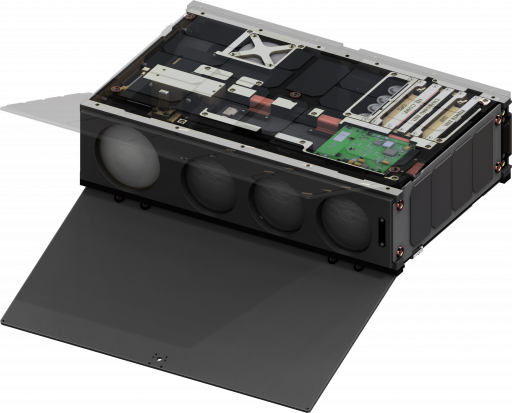
The Astro Digital Satellites employ a second-generation Ka-Band terminal suitable for cubesat missions. It comprises a horn antenna and polarizer, integrated QPSK modulator, DVB-S2 converter and transmitter units, reaching a switchable downlink data rate of 10 and 40Mbps, enabling a large volume of data to be downlinked during 11-minute ground station passes on every orbit.
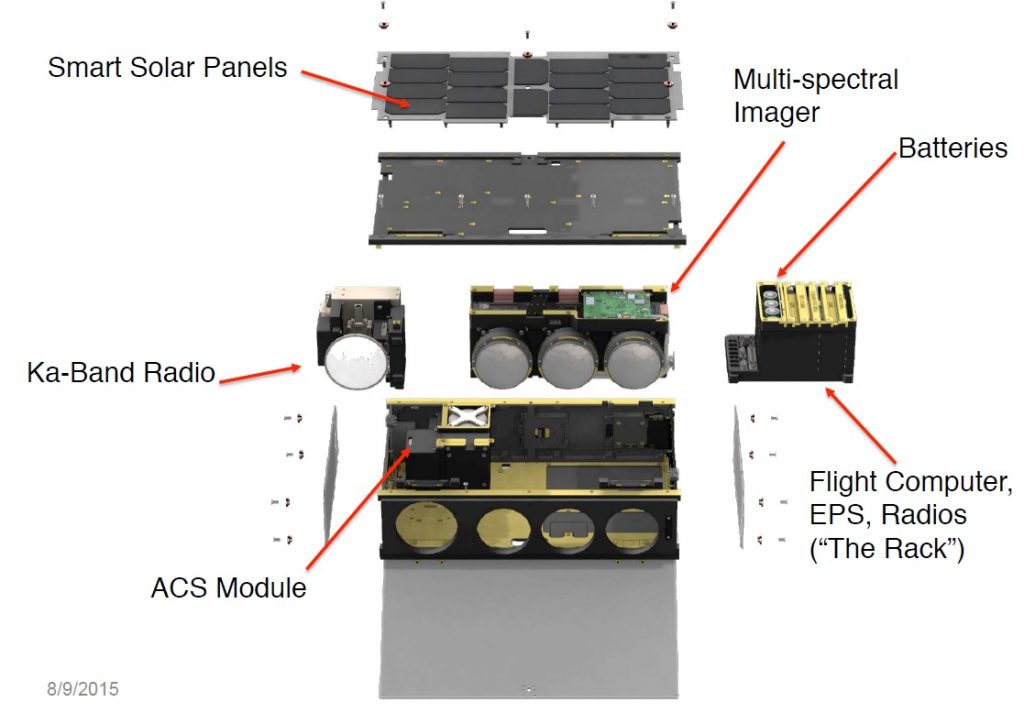
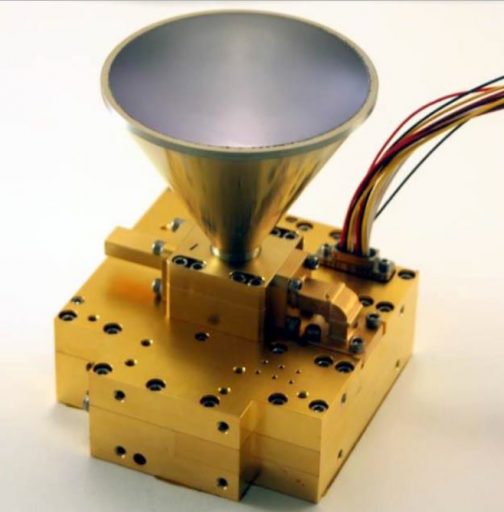
The Ka-Band unit accepts Ethernet UDP/IP packets from the satellite and delivers UDP/IP over DVB-S2 packets for downlink. The entire Ka-band terminal fits within approximately 1 CubeSat unit, requires 13 Watts of power during active transmission and delivers a 10.2-degree wide communications beam, requiring fairly precise pointing for communications; a future iteration of the system will be able to support data rates of 200Mbps.
The design of the Corvus-BC satellites makes use of self-contained units that can be assembled separately before being integrated into the satellite structure via simple interfaces to avoid complex system level work and allow for access to individual components until late in the assembly process. The principal units of the Corvus-BC satellite are the Data & Power Module, also called the Rack, the Attitude Control System module, the Ka-Band radio and the Multi-Spectral Imager.
The Data & Power Module hosts six boards that facilitate the satellite’s core functions – an Electrical Power System Board, a Battery Assembly with four Li-Ion batteries and a Charging Board are tasked with accepting power from the solar panels, conditioning the satellite’s power buses of 3.8, 5, 8 and 12 Volts and controlling the state of charge of the four batteries.
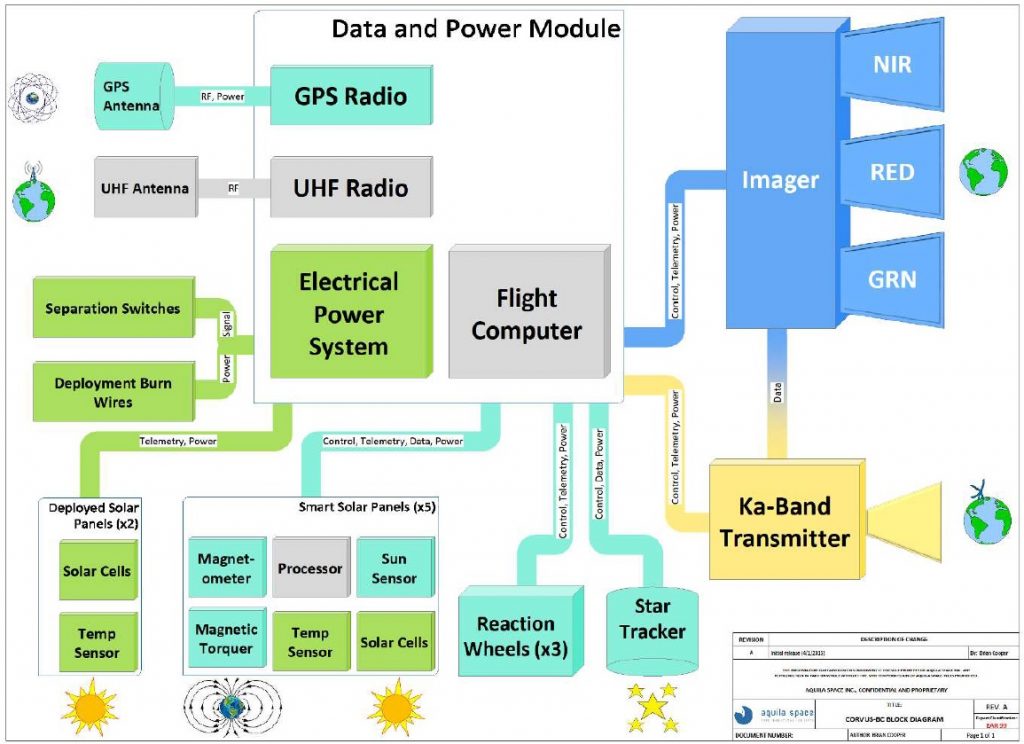
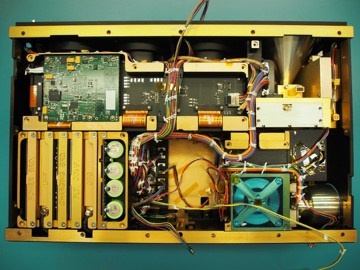
The TT&C radio is in charge of accepting ground commands and routing them to the onboard computer and conditioning housekeeping telemetry for downlink via UHF. The Flight Computer handles all satellite subsystems, processes & executes ground commands, and operates the payload module and a dedicated GPS board provides timing synchronisation and position information for imaging and geo-tagging.
The Rack employs a simplified design with a back plane containing the interfaces between the individual slices, allowing boards to slide into place and be secured via two screws. This design also allows for quick assembly and easy troubleshooting while the satellite is still on the ground.
The ACS assembly hosts the ST-16 star tracker and the three reaction wheels as well as the inertial measurement system, where five Smart Solar Panels facilitate the magnetometers, sun sensors and magnetic torquers – all controlled by an ARM M0+ processing unit. A small free volume inside the 6U satellite structure is available for the addition of a propulsion system on future Corvus-BC satellites to be able to actively maintain a craft’s orbit and optimise the constellation, transitioning from a loose constellation of CubeSats to a managed constellation that delivers optimal revisit times.
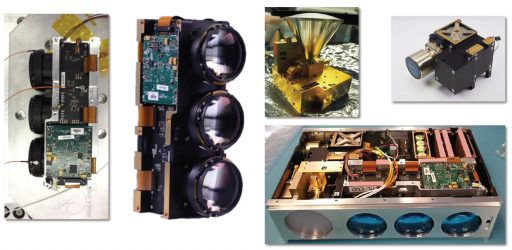
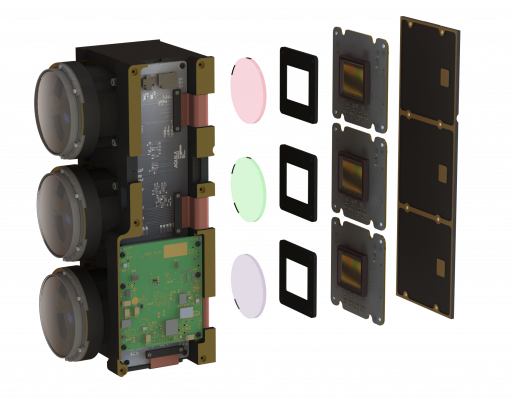
Corvus-BC has a 1TB data storage and a daily imaging capacity of 1.2 TB, corresponding to a ground coverage area of 150 million square Kilometres (for a Ka-Band link of 170 Mbps).
The Landmapper-HD constellation will comprise 20 Corvus-HD satellites that comply with the 16U form factor and weigh around 20 Kilograms, hosting a large telescope and a five-band imaging detector, covering a 25 km swath and reaching a ground resolution of 2.5 metres. An upgraded Ka-Band system with data speeds up to 1Gbps will enable each satellite to capture 15TB of data per day, equivalent to a coverage area of 25 million km². 2)
Landmapper Demo
Landmapper-Demo is a technology demonstration mission consisting of two separate, identical spacecraft: Landmapper-Demo6 (Demo6) and Landmapper-Demo7 (Demo7). Each spacecraft includes two payloads: an optical communication system; and a high-performance payload data processor.
Landmapper-Demo6 and Demo7 are based on the standard Corvus-XL bus and each has a total mass of approximately 80 kg with dimensions of 0.524 m x 0.524 m x 0.62 m. The main solar panel is fixed to the body and overhangs the spacecraft body in the -X axis, making it 1.2 m long in total. There are two Optical Intersatellite Link units (OISLs) for communication between satellites using laser technology, one attached to the +Z face of the spacecraft and one on the -Z face.
The superstructure consists of 6 aluminium iso-grid outer panels and all the internal components are attached to the inner faces of these 6 structural panels. There is a 15-inch Planetary Systems Lightband on the +X face of the spacecraft that is used to deploy the spacecraft from the launch vehicle as well as two independent TT&C antennas protruding from the +X face of the spacecraft and are canted by 45 degrees in the +Y and -Y direction respectively. Two S-band TT&C antennas are placed on the +Z face and the -Z face and feed into the same TT&C radio to allow for full hemispherical coverage.
The spacecraft includes two independent GPS receivers and both of their antennas are placed on the -Z face and a star tracker points out of the -X face. The spacecraft includes two independent propulsion systems, the first is a mono-propulsion chemical system with approximately 1000 Newton-seconds of total impulse and a maximum thrust of 1 Newton. The second is a field emission electric propulsion system with a total impulse of 6000 Newton-seconds and a maximum thrust of 350 micronewtons.
Power is locked away from all spacecraft platforms and payload components by means of redundant series separation switches. These switches cannot be activated until the spacecraft is deployed from the launch vehicle. The bus electronics are largely identical to many past Astro Digital missions. The Flight Computer, low-level Electrical Power System, TT&C transceiver, and GPS receiver have all been flying as a system on orbit since 2017 on various missions including Corvus-BC1-4, Sirion Pathfinder-2, and Momentus X1. The attitude determination and control system has been operating on orbit since 2014 on Perseus-M1 and Perseus-M2. The high voltage electrical power system has been qualified for flight. The spacecraft is depicted in Figure 8. 3)
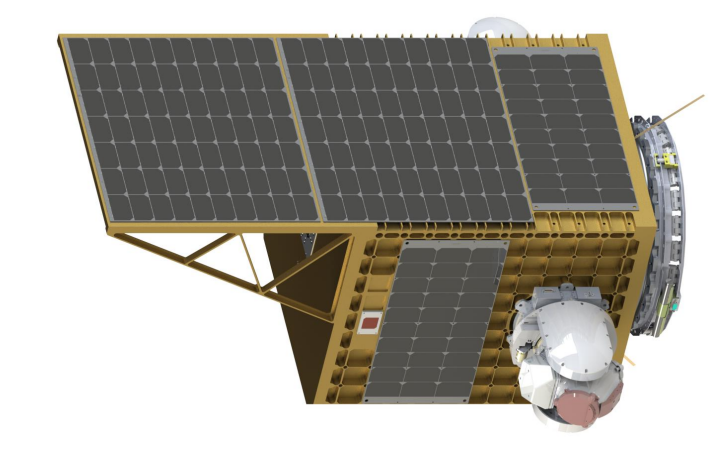
Launch
- Corvus-BC 1 and 2 were launched on the Soyuz-2-1a Fregat rocket on July 14, 2017 from Tyuratam (Baikonur Cosmodrome), Kazakhstan. They both failed shortly after launch due to a stage-1 spillage of hydrazine. 7)
- Corvus-BC 3 was launched as a co-passenger on the Soyuz-2-1b Fregat rocket on November 28, 2017 but was lost due to an upper stage problem, it was successfully relaunched on January 12, 2018 on the PSLV-XL rocket.
- Corvus-HD suborbital test flight was successfully launched on August 2, 2017 on the Vector-R rocket.
- Corvus-BC 4 was launched December 3, 2018 upon the SpaceX Falcon-9 v1.2 rocket from Air Force Western Test Range (AFWTR).
- Corvus-BC 5 was launched on November 20, 2020 from the Rocket Lab Launch Complex (RLLC).
All satellites were launched into a sun-synchronous orbit at various altitudes, see Table 1. 4) 5)
Mission | Period (minutes) | Inclination | Altitude (km) |
Corvus-BC 3 | 94.1 | 97.3° | 481.2 |
Corvus-BC 4 | 96.2 | 97.6° | 584.8 |
Corvus-BC 5 | 94.1 | 97.5° | 481 |
Mission Status
- December 2022: All five satellites are still in orbit although Corvus-BC 1 and 2 are non-operational. Corvus-BC 3, 4, and 5 are all still operational.
- August 3, 2017: Vector Space Systems successfully completed their second launch test of the Vector-R rocket, this time with an experimental Landmapper-HD payload onboard. 6)
- July 14, 2017: Soyuz Fregat rocket suffered a hydrazine spillage causing nine cubesats on board to be unresponsive to commands, including Corvus-BC 1 and 2. 7)
Sensor Complement
The imaging payload of the Corvus-BC satellites comprises three nearly identical imagers that are only distinguished by their spectral filters to collect imagery in the Landsat bands. Corvus-BC covers a green band (520-600 nm), red (630-690 nm) and a near infrared band (770-900 nm) using imagers with a 21.0 by 14.9-degree field of view to capture imagery across a 220-Kilometre swath with a nominal resolution of 22 metres.
The 70-megapixel CMOSIS CHR70M image sensors are high resolution image sensors with 10000 by 7096 pixels. The image array consists of 3.1 μm x 3.1 μm pinned diode pixels which share a number of transistors (2 pixels sharing). The image sensor has 8 analog outputs, each running at 30MHz. They employ electronic rolling shutters and operate at a frame rate of 0.5 frames per second; Field Programmable Gate Array technology is used for conversion of the analog sensor data to digital images with a 12-bit depth. 2) 9)
Ground Segment
Astro Digital has developed and partnered with KSAT to deploy a collection of ground stations around the globe in support of their own missions and those of their customers. Existing capabilities included UHF TT&C and High Speed Ka-band Downlink with planned expansion into Optical, S, X, and V-band in the coming years. 10)
The 23 dBiC circularly polarised quad Yagi antenna consists of four Yagi antennas with crossed elements. The array of quad-stacked crossed elements consists of two columns of two horizontally stacked Yagis. For satellite command and control, the transmitting antenna provides circular polarisation and can be configured to work as RHCP or LHCP (right or left polarisation). Circular polarisation delivers better penetration through interference and obstruction. 11)
Rotator controller steered with Gpredict tracks the desired satellite and rotates the antenna autonomously. Gpredict is used because it offers fast and accurate real-time satellite tracking using the NORAD SGP4/SDP4 algorithms. 8) 12)
References
1) “NSSDCA - Spacecraft - Details.” NASA - NSSDCA - Spacecraft - Details, https://nssdc.gsfc.nasa.gov/nmc/spacecraft/display.action?id=2018-099K.
2) Blau, Patrick. “Corvus-BC – Soyuz – 73 Satellites.” Spaceflight101, https://spaceflight101.com/soyuz-kanopus-v-ik/corvus-bc/.
3) “Astro Digital Landmapper-Demo Orbital Debris Assessment Report (ODAR) ODAR-1.1.” FCC Report, 8 May 2020, https://fcc.report/IBFS/SAT-AMD-20200528-00064/2384162.pdf.
4) “Landmapper.” Wikipedia, https://en.wikipedia.org/wiki/Landmapper.
5) “Landmapper-BC 1, ..., 12 (Corvus-BC 1, ..., 12) - Gunter's Space Page.” Gunter's Space Page, https://space.skyrocket.de/doc_sdat/landmapper-bc.htm.
6) “Vector micro-rocket launch w.” Astro Digital, 3 August 2017, https://blog.astrodigital.com/vector-micro-rocket-launch-w-astro-digital-cce05084309.
7) Werner, Debra. “Insurance firm paid Astro Digital's claim for lost cubesats, sources said.” SpaceNews, 9 March 2018, https://spacenews.com/insurance-firm-paid-astro-digitals-claim-for-lost-cubesats-sources-said/.
8) “Perseus-M On-Orbit Report and Corvus-BC Satellite Design.” 23 April 2015, http://mstl.atl.calpoly.edu/~workshop/archive/2015/Spring/Day%202/0920-Bertino%20and%20Cooper-Corvus%20BC%20and%20Perseus%20M%20Report.pdf
9) “Product Document.” Product Document, https://ams.com/documents/20143/36005/CHR71000_DS000427_1-00.pdf/d0ced48c-fd6a-b3d9-b9da-d3612a3e2df4.
10) “Systems.” Astro Digital, https://astrodigital.com/systems.
11) “Quad Stacked Circular Polarized Yagi Antenna.” Antenna Experts, https://www.antennaexperts.in/product-detail.asp?cat=quad-stacked-circular-polarized-yagi-satellite-antenna&id=23.
12) “Gpredict Features.” Gpredict, http://gpredict.oz9aec.net/features.php.